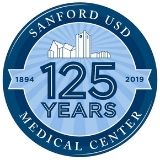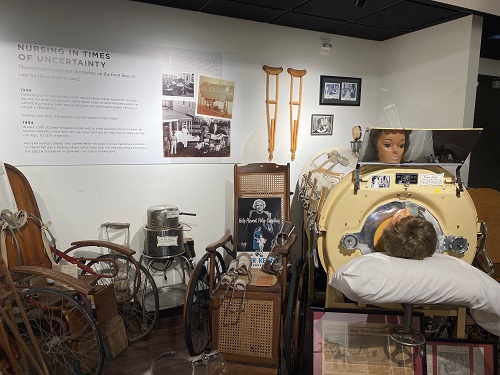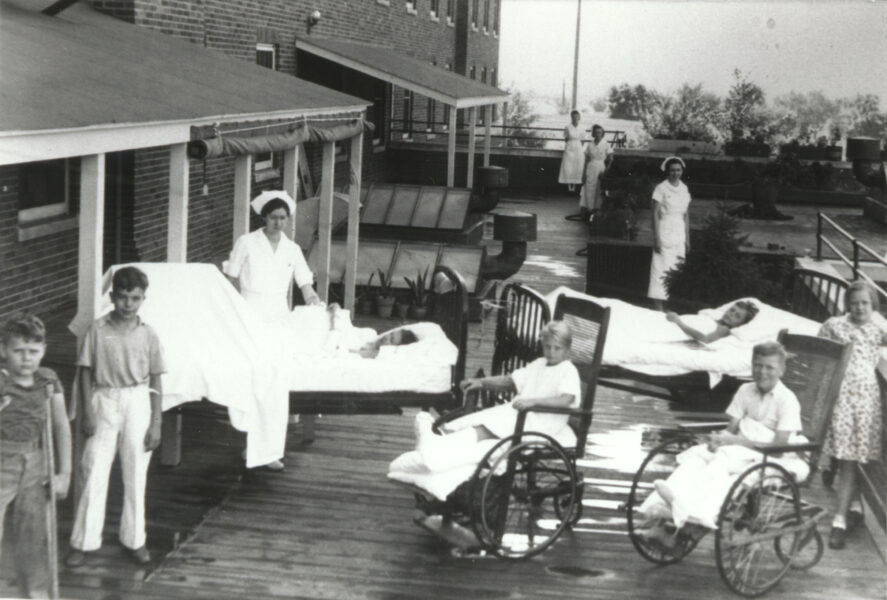
In times of a health crisis, communities and their surrounding area turn to hospitals for care, guidance and expertise.
During the influenza epidemic of 1918, for example, so many patients came to Sioux Falls Lutheran Hospital (now Sanford USD Medical Center) that they had to be housed in hallways, offices and the parlor, according to the book “An Institution of Organized Kindness,” written by nurse Narcy Recker at the time of the hospital’s 100th anniversary.
In the middle of that century, another kind of epidemic took over the hospital.
Representing that epidemic is one of the most fascinating curiosities in the Sioux Empire Medical Museum: the iron lung. And in case you might have trouble imagining having polio and lying in an iron lung on your back with only your head protruding, an obliging dark-haired mannequin illustrates the scenario. The museum exhibit lies just off the Sanford USD Medical Center concourse below 18th Street.
Polio epidemics

Photo by Sanford Health
Thanks to the polio vaccine, first available in the U.S. in 1955, we can remain blissfully ignorant about the existence of a contagious virus that once gripped the country in epidemics — and in deep fear. But the iron lung, which helped paralyzed chest muscles stave off death with mechanical breathing, still symbolizes that fear. That utter helplessness.
The epidemics hit Sioux Falls particularly hard in the late 1940s and early ’50s. In a single year, 1948, nearly 400 people came to Sioux Valley Hospital with polio, according to Recker’s book.
At one point, 103 patients in the 190-bed hospital had polio, with 14 of them in iron lungs, the book detailed. The iron lungs were intended to be used temporarily as patients recovered, or sometimes succumbed to the disease. In that year of 1948, 68 people died. Three floors of the hospital were filled with polio patients.
Along with the public, the staff dreaded the disease because so little was known about it, including transmission. (We now know polio spreads through exposure to an infected person’s feces, or sneezing or coughing.)
It especially seemed to affect children, but “it was no respecter of persons,” said retired nurse Arlayne Ruhaak, who graduated from the hospital’s nursing school in 1951. Someone of any age, sex, residence or occupation could become infected. Ruhaak remembered another nurse contracting polio and having to quit working because of how it had affected her leg and movement.
Mumps and pranks, on top of polio
Dee Whitney, a 1953 nursing graduate, remembers working on the polio floor in 1951 and 1952 during nursing school. Thanks to the passage of time, you could almost call them lighthearted.
Here’s one:
“We had three iron lungs in a room, and they were all little boys. And I worked the evening shift in there, and we’d get them ready for bed. And we’d always give them a kiss on their forehead, because they were quite young.
“The next morning, someone called me and said, ‘All these kids have high temps, and we think they have the mumps. Have you had them?’ I said, ‘No, I haven’t,’ and so I got them 18 days later.”
But she still recalled caring for those boys and other polio patients as “a wonderful experience.”
Whitney also remembers other boys who had been through the worst of the disease and were on the mend. Lots of energy, all confined to a hospital ward.
“They were just the naughtiest kids you’ve ever seen. They played pranks on us,” Whitney said. But she sympathized with them.
“They were just so pent up in there.”
Before polio hit, Sioux Valley Hospital had a ward and educational system set up for children with disabilities. Some of them stayed in the hospital, and some just came for classes, Recker’s book said. The need for more room — especially to accommodate the number of kids left with disabilities in the wake of a polio epidemic — led to the 1952 opening of a separate facility in Sioux Falls, Crippled Children’s Hospital and School, now called Lifescape.
Helping communities
Sanford Health‘s history of responding to the needs of the community and region stretches back to its start in 1894. It continued beyond the devastating midcentury polio epidemics to the development of an air transport system to try to reduce the state’s high infant mortality rate in 1976, and to the offer of genetic testing at no cost to veterans today.
“Similar to today, the health system wants people to know that they’re part of the community, and they’re doing things to help the community. That’s what we tried to do back then,” said Lyle Schroeder, who served as the head of then-Sioux Valley Hospital from 1961 to 1997. “We said, look, it’s your hospital. We’re a not-for-profit community hospital, and we’re doing things that we think you need.”
Paul Hanson, current president of the Sioux Falls region for Sanford Health, also sees community involvement as essential to the mission of Sanford Health — and he saw it extended firsthand in Bemidji, Minnesota. Hanson served as president and CEO of North Country Health Services there when it merged with Sanford Health in 2011. He became the market president for Sanford Health’s Northern Minnesota region.
Beyond medical services, Sanford Health contributed to the events center there as well as Bemidji State University. Sanford Health also invested in economic development to help bring new businesses and other resources to the community.
“We stepped it up, made the pledge, and it literally changed that economic development group overnight,” Hanson said.
Hanson extends the community involvement mission to employees as well.
“We will be part of any community that we’re in. We’re going to be incredibly supportive of the community that we’re in,” Hanson said. “… When I look at our employees now that give back to initiatives within the community or within our own Sanford family, they’re incredibly generous. … It’s part of who we are.”
Meaningful moments
Gestures of support are another way Sanford Health employees have given back, in the past and today.
Early in her nursing career, for example, Ruhaak recalled that the nurses who had to work on Christmas would create a festive atmosphere for patients.
“One of the most rewarding experiences,” she described it: “On Christmas morning, those of us that were around, we all gathered together, and we went caroling down the halls of the hospital before we had to go to work. And that was just very good.”
“Very touching,” Whitney agreed. “It was worth having to work on that weekend.”
Schroeder recalled connecting with a friend who lived two and a half hours away but had come to Sioux Valley Hospital for heart surgery. Schroeder visited him in his room the day before surgery.
“He was really very anxious and afraid, I think, of what was going to go on,” Schroeder said. “So I tried to comfort him.”
Schroeder told him about how well open-heart surgeries go, and how much better patients felt afterward.
“Then I got to go back and see him a few days later, and he was so thankful. While what I had to say was not very impressive to me, it was to him, and he appreciated it,” Schroeder said.
The difference Sanford Health and its employees can make to the life of a patient drives Hanson. Soon after he arrived in Sioux Falls for his current position, he was asked to talk with a family at Sanford Children’s Hospital. A surgeon had just performed a procedure that would help their child to talk, among other functions.
“To walk into that patient room and hear that child sing a song and do the ABCs for you when they couldn’t do that before they came — this is why I’m here.”
More about the hospital’s history
- Part 1: Tracing memories in Sanford Health’s 125-year mission
- Part 3: From roles to tools (and air conditioning), care has changed
- Sanford Health timeline: Rented house to regional network
…
Posted In Allied Health, Company News, Emergency Medicine, Family Medicine, Innovations, News, Nonclinical Support Services, Nursing and Nursing Support, Sanford Stories, Sioux Falls
